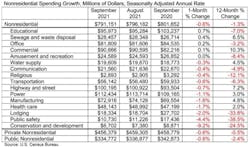Total construction spending declined in September for the first time since February, as both residential and nonresidential construction slipped, according to analysis of federal construction spending data by the Associated General Contractors of America.
“Spending on projects has been slowed by shortages of workers and materials, as well as extended or uncertain delivery times,” said Ken Simonson, chief economist, in a prepared statement.
Construction spending in September totaled $1.57 trillion at a seasonally adjusted annual rate, down 0.5 percent from August. Year-to-date spending in the first nine months of 2021 combined increased 7.1 percent from the total for January-September 2020. Although both residential and nonresidential construction declined from August to September, the two categories have diverged relative to 2020 levels. Residential construction spending slipped 0.4 percent for the month but was 24.5 percent higher year-to-date. Combined private and public nonresidential construction spending decreased 0.6 percent in September and 5.8 percent year-to-date.
National nonresidential construction spending contracted 0.6 percent in September, according to an Associated Builders and Contractors analysis. On a seasonally adjusted annualized basis, nonresidential spending totaled $791.2 billion for the month.
Spending was down in 11 of the 16 nonresidential subcategories, according to ABC, with both private and public nonresidential spending down 0.6 percent in September.
“Nonresidential construction spending has generally been trending lower for several months and the factors behind this are well known,” said Anirban Basu, ABC chief economist, in a statement. “First, the pandemic has continued, resulting in ongoing global supply chain disarray. That has kept commodity and materials prices higher than they otherwise would be, causing some project owners to pull back on construction starts.
“Second, many observers thought that America would have passed a meaningful infrastructure package by now. That has not yet happened, and many state transportation agencies, along with their local counterparts, note that planning for projects has become extraordinarily challenging in the context of uncertain federal funding.
“Finally, to the extent that projects are moving forward, construction skills shortages are slowing the pace of construction delivery,” said Basu. “Were an infrastructure package to pass, it is unclear how projects would be sufficiently staffed given a higher rate of retirement among construction workers and a lack of entry into the skilled trades. These factors have continued in recent weeks, suggesting that nonresidential construction spending may remain somewhat soft during the months ahead.”
Most infrastructure categories posted significant year-to-date declines, according to AGC’s Simonson. The largest public infrastructure segment, highway and street construction, was 1.3 percent lower than in January-September 2020. Spending on public transportation construction slumped 6.8 percent year-to-date. Investment in sewage and waste disposal structures was the sole exception, rising 4.3 percent, but public water supply projects dipped 0.9 percent and conservation and development construction plummeted 19.5 percent.




